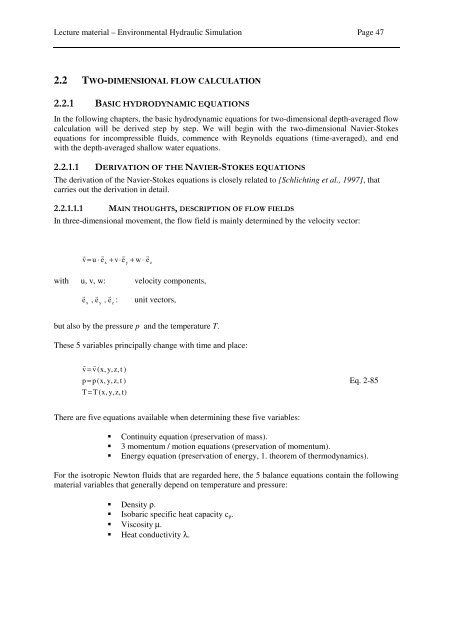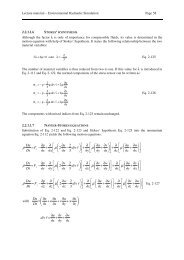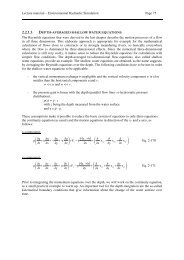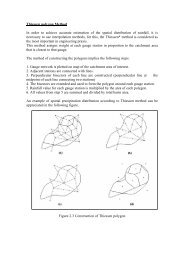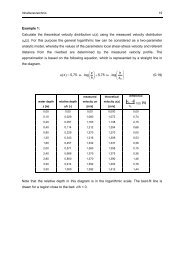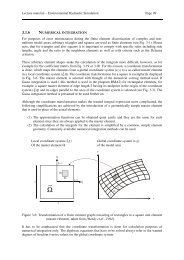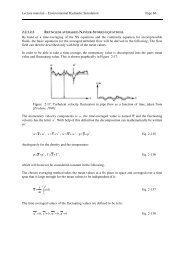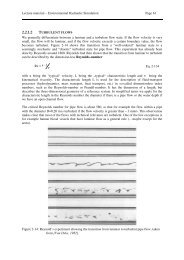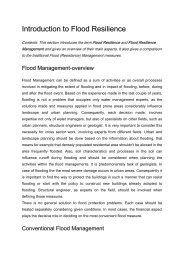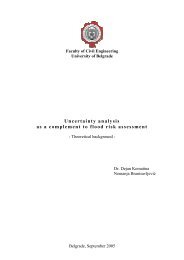Derivation of the Navier-Stokes equation
Derivation of the Navier-Stokes equation
Derivation of the Navier-Stokes equation
- No tags were found...
You also want an ePaper? Increase the reach of your titles
YUMPU automatically turns print PDFs into web optimized ePapers that Google loves.
Lecture material – Environmental Hydraulic Simulation Page 50The first two terms are <strong>the</strong> substantial derivative <strong>of</strong> <strong>the</strong> density over time. It is composed <strong>of</strong> <strong>the</strong> localpart for unsteady flows and <strong>the</strong> convective part due to change in place.This yields <strong>the</strong> continuity <strong>equation</strong>:Dρ⎛ ∂u∂v∂w⎞+ρ0Dt⎜ + +x y z⎟ =⎝ ∂ ∂ ∂ ⎠Eq. 2-95We now assume an incompressible fluid 1 . The first term <strong>of</strong> Eq. 2-95, that is <strong>the</strong> substantial derivative<strong>of</strong> <strong>the</strong> density over time, is zero under this precondition. The result <strong>of</strong> <strong>the</strong> continuity <strong>equation</strong> is <strong>the</strong>nthat incompressible fluids are solenoidal and <strong>the</strong> continuity <strong>equation</strong> can be written as:⎛ ∂u∂v∂w⎞div v = 0 or ⎜ + + ⎟ = 0Eq. 2-96⎝ ∂x∂y∂z⎠The constant density in <strong>the</strong> flow field is a commensurate, but not a necessary condition forincompressible flows.2.2.1.1.2.2 Momentum / motion <strong>equation</strong>sThe momentum <strong>equation</strong> is a basic law <strong>of</strong> mechanics. It states that mass times acceleration is equal to<strong>the</strong> sum <strong>of</strong> forces that act on a volume unit. We differentiate between mass forces (weight forces) andsurface forces (pressure and friction forces).dI = dm t ⋅v( )1dVdIdt=1dVddt ∫ ρ ⋅v dV = F + PVEq. 2-97F : mass force per volume unitP : surface force per volume unitWith fur<strong>the</strong>r simplification we get:1 A fluid, which does not change it’s density at <strong>the</strong> pressure from outside, is called incompressible. In nature, allfluids are always compressible. For most calculations <strong>the</strong> fluid may still be granted as an incompressible fluid, as <strong>the</strong>error is negligibly small. Moreover, this assumption simplifies <strong>the</strong> calculation enormously. In <strong>the</strong> technical hydraulics<strong>the</strong> compressibility, for example, <strong>of</strong> a hydraulic fluid should be kept clearly in mind.
Lecture material – Environmental Hydraulic Simulation Page 511dVddt∫ρ ⋅v dV =1dV∫DDt( ρ ⋅v)dV1dVDDt⎛⎜1 ⎜ Dρ dVdV⎜ + Dt⎜= 0,⎝ incompressible( ρ ⋅v dV ) = v ( ρ dV )⎞ ⎟Dv ⎟Dt⎟⎟⎠Eq. 2-98Dv= ρDtThe last expression contains <strong>the</strong> substantial acceleration that is composed <strong>of</strong> <strong>the</strong> local and <strong>the</strong>convective acceleration: Dv∂vdv ∂v = + = + ( v ⋅ grad)vEq. 2-99Dt ∂tdt ∂tThis <strong>equation</strong> makes <strong>the</strong> transition from <strong>the</strong> Lagrange point <strong>of</strong> view, that has no reference to space, butonly regards changes in time, to <strong>the</strong> Eularian point <strong>of</strong> view, which accounts for <strong>the</strong> translation part byconvective transport. The momentum <strong>equation</strong> with <strong>the</strong>se changes is: Dv⎛ ∂v ⎞ ρ = ρ ⎜ + ( v ⋅ grad) v⎟=F+PEq. 2-100Dt ⎝ ∂t⎠The mass forces are to be seen as given, outside, forces, in opposition to <strong>the</strong> surface forces that dependon <strong>the</strong> deformation state <strong>of</strong> <strong>the</strong> fluid. The total <strong>of</strong> surface forces makes a stress state. Now a connectionbetween <strong>the</strong> stress state and <strong>the</strong> deformation state has to be made. This is done with help <strong>of</strong> <strong>the</strong>transport <strong>equation</strong>.All fur<strong>the</strong>r considerations will be limited to isotropic Newton fluids. All gases and many liquids,especially water, belong to this category. If <strong>the</strong> relation between all components <strong>of</strong> <strong>the</strong> stress tensorand <strong>the</strong> deformation velocity tensor is <strong>the</strong> same for all directions, <strong>the</strong> fluid is considered isotropic. Ifthis relation is linear it is considered a Newton fluid. The <strong>equation</strong> for <strong>the</strong> momentum transport iscalled <strong>the</strong> Newton or <strong>Stokes</strong> friction law in this case.


